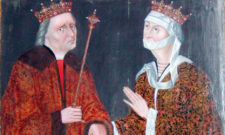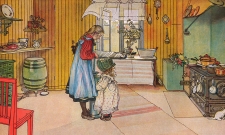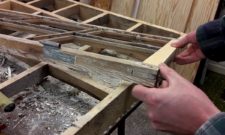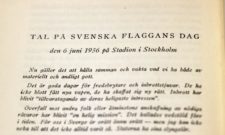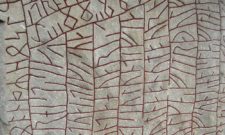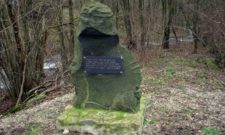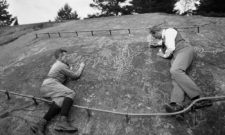Sägner
Ljungby horn and pipe
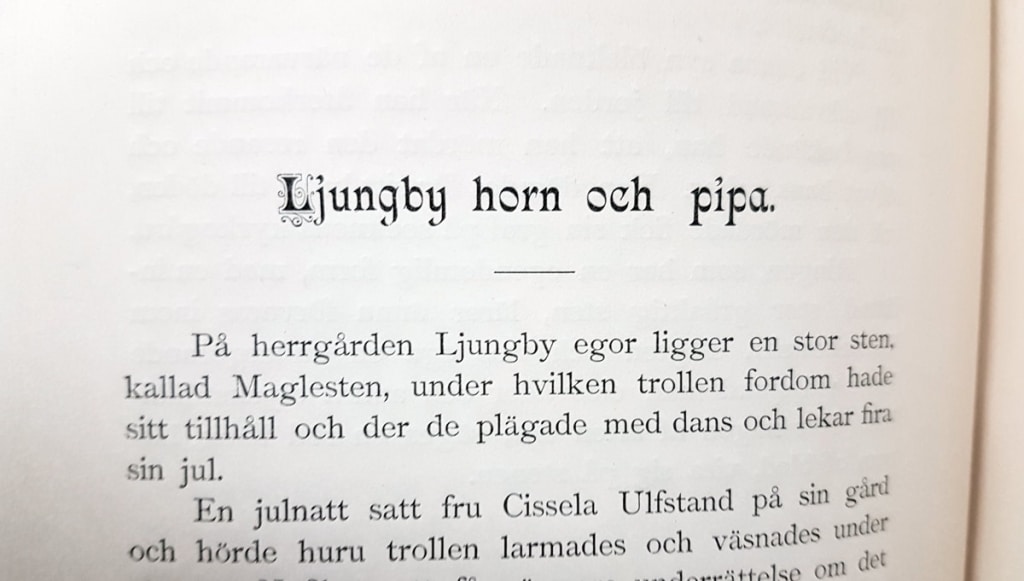
Sep
Ljungby horn and pipe is a drinking horn with silver gilt fittings and a whistle made of bone that is stored on Trolle-Ljungby Castle in Skåne. According to legend, the objects were stolen from the trolls at the enormous Maglestenen. The horn and the pipe are displayed today in a glazed niche in the castle courtyard.
On the manor Ljungby egor is a large stone, called Maglesten, under which the trolls used to have their shelter and where they used to celebrate their Christmas with dancing and games.
One Christmas night, Mrs. Cissela Ulfstand sat in her yard and heard the sound of the trolls and their noises under the stone. Curious to learn more about the mysterious mountain people, she lent her best horse to anyone who wanted to ride to Maglesten at Christmas time and find out about the relationship.
One of her friends, a young man, agreed to the proposal and went to town. Arrived at the stone, he saw it raised on golden poles, and the trolls beneath it rejoicing.
A young sorceress came out to meet him with a drinking horn and a pipe, telling him first to drink the mountain king's bowl and then to blow three times into the pipe. The boy received both, but was at the same moment given a piece of good advice by an unknown woman, whereupon he poured out the drink over his shoulder and set off in single file across fields and meadows back to the farm. The trolls pursued him with wild cries; but he beat them into the castle, and, the drawbridge having been drawn up, left the goods in his mother's hands.
Outside the castle courtyard now stood the trolls, praising Mrs. Cissela's good fortune and great riches if she would return the horn and the pipe, but if not, misfortune and ruin would befall both herself and her family. In particular, the worst misfortune would befall anyone who dared to move the treasures from Ljungby. The man who had taken them died on the third day after the visit to Maglesten, and the horse fell the next day.
During the war of 1645, Field Marshal Gustaf Horn, who had his headquarters in Fjelkinge, asked to see the horn and the pipe and sent messengers to remove them. When the ogre Axel Gyllenstierna, who then owned Ljungby, wanted to comply with his request, he did not dare to refuse, but exiled the two trolls, but with an insistent request to get them back as soon as possible. Nor did Horn feel any desire to have them in his custody, for as long as he kept them he was disturbed every night by noise and commotion, which ceased when, under escort of a company of horsemen, he sent them back to Ljungby.
Ten years later, an even more wonderful event occurred. Henrik Nilsson, the vicar of Ljungby, had borrowed the wonderful things to show to his brothers-in-law, who had come to visit him. In the night, the priest's mother-in-law, Mrs Anna Conradi, was awakened by a flash of light in the room. The bedclothes were drawn back and on her bed was lowered a basket, in which sat five little children, crying:
"Oh, please! be good, and grant that we may have our horn again!"
When she asked them why they wanted it, and what value the horn had for them, they answered:
"For the sake of our flock."
When she would not listen to their prayers, they said they would come again in half a third night.
On Thursday night, three days later, the room was again light. When Mrs. Anna drew back the bed-cover, she saw a whole crowd of little leprechauns on the golf-bed, and among them the Wizard King himself, walking under a sky of silver cloth, carried on silver poles by four servants. He was of a blackish-brown colour, with black woolly hair, of which only a tuft of fans grew on his forehead and one on each ear. Slowly he approached the bed, holding a horn with a lid, adorned with gold chains and solid gold buttons, which he promised to give in exchange for the real horn But the old woman would not be wooed, but banished them to God, if they belonged to him, or to the devil, if they were his offspring, whereupon the trolls quietly and sorrowfully departed.
Shortly afterwards the child of a squire's wife is said to have been taken away by the trolls, but by ringing the church-bell returned to the mothers. The boy told that the trolls were not beautiful, but had large noses and mouths; that the man under Maglesten was called Klausa, and his wife Otta; that they sucked the must out of men's food; that they were under a king; that they often disagreed; and that they spoke the language of the country. The Court Chancellor Coyet, who wrote a "Relation of Ljungby Horn and Pipe," dated February 11, 1692, says he knew this boy, then twenty-seven years old, as well as his mother, but admits that both were prone to superstition, and their minds were as weak as their bodies.
Source: Hofberg, Herman, Swedish folk tales, 1882
Read more
Wikipedia, Ljungby horn and pipe
Subscribe to YouTube:
If you appreciate Allmogens independent work to portray our fine Swedish history and Nordic culture, you are welcome to buy something nice in the shop or support us with a voluntary donation. Thank you in advance!
Support Allmogens via Swish: 123 258 97 29
Support Allmogens by becoming a member
Support Allmogens in your will
Historical maps of Skåne
Our wall maps are carefully restored, centuries-old maps that are reprinted in Ångermanland on matte, age-resistant, museum-quality premium paper. 1% of the proceeds go directly back to cultural heritage!
